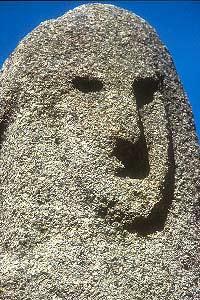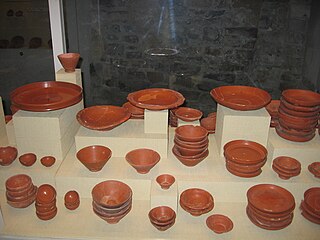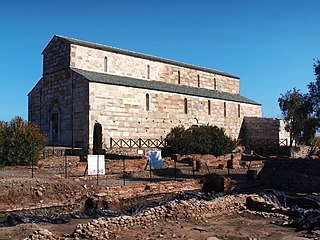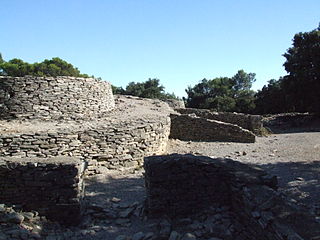 W
WAlesia was the capital of the Mandubii, one of the Gallic tribes allied with the Aedui. The Celtic oppidum was conquered by Julius Caesar during the Gallic Wars and afterwards became a Gallo-Roman town. Modern understanding of its location was controversial for a long time; however, it is now thought to have been located on Mont-Auxois, near Alise-Sainte-Reine in Burgundy, France.
 W
WAmbrussum is a Roman archaeological site in Villetelle, Hérault département, in southern France.
 W
WGlanate was a Gallo-Roman town on the right bank of the Var, which became the episcopal see of Glandève.
 W
WThe Roman city of Argentomagus was located in the Mersans plateau of central France, at the strategic point on the north bank of the River Creuse, where a Roman bridge once traversed. It was located at the crossing of two roads—Cenabum (Orléans) to Augustoritum (Limoges), and Limonum (Poitiers) to Avaricum (Bourges). The Latin name of the city meant "Silver Market." The modern town of Argenton takes its name from the ancient site of Argentomagus.
 W
WBeaumont-en-Verdunois is a commune in the Meuse department of the Grand Est region of northeastern France.
 W
WBezonvaux is a commune in the Meuse department in the Grand Est region in northeastern France.
 W
WBibracte, a Gallic oppidum or fortified settlement, was the capital of the Aedui and one of the most important hillforts in Gaul. It was situated near modern Autun in Burgundy, France. The material culture of the Aedui corresponded to the Late Iron Age La Tène culture.
 W
WCézembre is an island in Brittany, in the Ille-et-Vilaine département of France, near Saint-Malo. The island is uninhabited, with a surface area of approximately 18 hectares, a length of 750 metres (2,461 ft), and a maximum width of 250 metres (820 ft).
 W
WCherré is the site of the archeological excavation of a Gallo-Roman complex of 20 hectares from the 1st to the 3rd centuries. It is situated in the town Aubigné-Racan, in the Sarthe département of western France, in the région Pays de la Loire.
 W
WCorent is a commune in the Puy-de-Dôme department in Auvergne-Rhône-Alpes in central France.
 W
WCumières-le-Mort-Homme is a ghost commune in the Meuse department in Grand Est in north-eastern France.
 W
WThe Oppidum d'Ensérune is an ancient hill-town near the village of Nissan-lez-Ensérune, France, located between Béziers and Narbonne close to the D609 and Canal du Midi. It has been listed since 1935 as a monument historique by the French Ministry of Culture.
 W
WFilitosa is a megalithic site in southern Corsica, France. The period of occupation spans from the end of the Neolithic era and the beginning of the Bronze Age, until around the Roman times in Corsica.
 W
WFleury-devant-Douaumont is a commune in the Meuse department in Grand Est in north-eastern France.
 W
WGlanum was an ancient and wealthy city which still enjoys a magnificent setting below a gorge on the flanks of the Alpilles mountains. It is located about one kilometre south of the town of Saint-Rémy-de-Provence.
 W
WHaumont-près-Samogneux is a commune in the Meuse department in Grand Est in north-eastern France.
 W
WLa Graufesenque is an archaeological site 2 km from Millau, Aveyron, France, at the confluence of the rivers Tarn and Dourbie. As Condatomagus, it was famous in the Gallo-Roman period for the production of high quality dark red terra sigillata Roman pottery, which was made in vast quantities and exported over much of the western part of the Roman Empire.
 W
WHuelgoat is a commune in the Finistère department of Brittany in northwestern France.
 W
WLouvemont-Côte-du-Poivre is a commune in the Meuse department in Grand Est in north-eastern France.
 W
WLuc-en-Diois is a commune in the Drôme department in southeastern France. It is situated on the Drôme River.
 W
WSaint-Bertrand-de-Comminges is a commune (municipality) and former episcopal see in the Haute-Garonne department in southwestern France. It is a member of the Les Plus Beaux Villages de France association.
 W
WMariana is a Roman site south of Biguglia, in the Haute-Corse département of the Corsica région of south-east France. It lies in the littoral area known as La Marana, near the present town of Lucciana. There are two old churches in the area — the Church of Santa Maria Assunta and San Parteo Church.
 W
WMontaillou is a commune in the Ariège department in the south of France. Its original, medieval location was abandoned and the current village is a short distance away.
 W
WThe Oppidum de Nages or Oppidum des Castels is on a hilltop overlooking the valley called the Vaunage, above the village of Nages-et-Solorgues, in Gard, between Nîmes et Sommières, in Occitanie, France. It is one of six iron-age oppida in the Vaunage, occupied between 800 BCE and 50 BCE. It has been listed since 1980 as a monument historique by the French Ministry of Culture.
 W
WThe Oppidum de Roque de Viou is on a hilltop overlooking the valley called the Vaunage, above the village of Nages-et-Solorgues, in Gard, between Nîmes et Sommières, in Occitanie, France. It is in the commune of Saint-Dionizy and is one of six iron-age oppida in the Vaunage; about 200m from the Oppidum de Nages or Oppidum des Castels. It was occupied in three periods between 700 BC and 600 BC and between 350 BC and 300 BC and around 50 BC. It has been listed since 1980 as a monument historique by the French Ministry of Culture.
 W
WOn 10 June 1944, the village of Oradour-sur-Glane in Haute-Vienne in Nazi-occupied France was destroyed when 642 of its inhabitants, including non-combatant women and children, were massacred by a German Waffen-SS company.
 W
WOrnes is a commune in the Meuse department in Grand Est in north-eastern France. The village is one of the nine French villages destroyed in the First World War and one of six that was never rebuilt. It's now a memorial place.
 W
WTerra Amata is an archaeological site in open air located on the slopes of Mount Boron in Nice, at a level 26 meters (85 ft) above the current sea level of the Mediterranean. It was discovered and excavated in 1966 by Henry de Lumley. The site, originally on a prehistoric beach, contained tools of the Lower Paleolithic period, dated to about 400,000 BCE, as well as traces of some of the earliest domestication of fire in Europe. The site now lies beneath an apartment building and a museum of prehistoric Nice, where some of the objects discovered are on display.